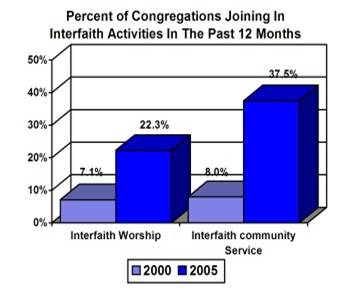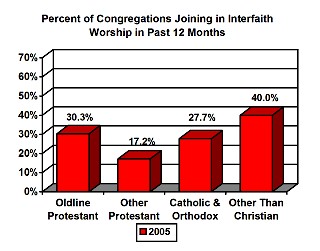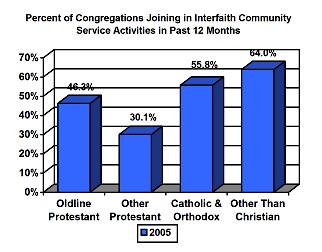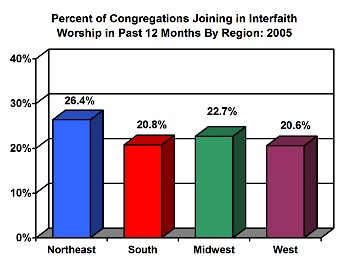A Quick Question
Has interfaith worship increased since 9-11?
The quick answer: Interfaith worship service participation has increased dramatically, but interfaith community service has grown at an even more rapid rate.
The longer answer: The latest national survey of U.S. faith communities found that interfaith activity among faith communities has more than tripled since 2000. The survey, sponsored by the Cooperative Congregational Studies Partnership, found that slightly more than 2 in 10 (22.3%) congregations reported participating in an interfaith worship service in the past year. Nearly 4 in 10 (37.5%) congregations reported joining in interfaith community service activities.
 These figures are from the just released Faith Communities Today 2005 (FACT2005) survey of 884 randomly sampled congregations of all faith traditions in the United States. The survey updates results from a survey taken in 2000, before the 9-11 terrorist attacks. FACT2000 found that only 7% of congregations reported participating in interfaith worship in the previous 12 months, while only 8% reported joining in interfaith community service activities. These figures are from the just released Faith Communities Today 2005 (FACT2005) survey of 884 randomly sampled congregations of all faith traditions in the United States. The survey updates results from a survey taken in 2000, before the 9-11 terrorist attacks. FACT2000 found that only 7% of congregations reported participating in interfaith worship in the previous 12 months, while only 8% reported joining in interfaith community service activities.
David A. Roozen, Director of the Cooperative Congregational Studies Partnership, said “immediately after September 11 there was a surge of interfaith activity, but by the following year many social commentators were talking about a return to the general interfaith indifference of pre-2001. There was no hard data to support or refute such claims. Now we know, four years later. The increased attention being given by communities of faith to interfaith engagements continues to be dramatic.”
The FACT2005 survey also shows that interfaith worship is significantly higher for mainline Protestant congregations (30%) than for other Protestantism (17%), and slightly higher among  mainline Protestants than for the Catholic and Orthodox faith family (28%). [“Other Protestant” includes both evangelical and historically black Protestant groups.] mainline Protestants than for the Catholic and Orthodox faith family (28%). [“Other Protestant” includes both evangelical and historically black Protestant groups.]
But it is highest among congregations in faith traditions other than Christian (40%). The latter makes sense, according to Roozen, “Because as minority faith traditions in the U.S. context, they arguably have most to gain from increased understanding and tolerance; and also because of demographics, they tend to be concentrated in cosmopolitan areas where there are larger numbers of Christian congregations seeking to partner with relatively small numbers of other than Christian communities.”
 In terms of interfaith community service activities, the faith family pattern runs from “other than Christian” as the highest (64%), followed by Catholic and Orthodox (56%), mainline Protestant (46%) and other Protestant (30%). It makes sense that the relative ranking of Catholic and Orthodox interfaith involvement in community service is higher than for interfaith worship, Roozen said, because of the unique sacramental practice and theology that defines worship in this tradition. In terms of interfaith community service activities, the faith family pattern runs from “other than Christian” as the highest (64%), followed by Catholic and Orthodox (56%), mainline Protestant (46%) and other Protestant (30%). It makes sense that the relative ranking of Catholic and Orthodox interfaith involvement in community service is higher than for interfaith worship, Roozen said, because of the unique sacramental practice and theology that defines worship in this tradition.
Levels of interfaith worship do not vary greatly by region of the country, according to the survey, although and not surprisingly it is slightly lower in regions of evangelical strength like the South and West and higher in regions with higher concentrations of mainline Protestant congregations like the Northeast and the Midwest . .
The complete report on the FACT2005 survey is projected for August, 2006. The FACT2000 and FACT2005 surveys were conducted by Faith Communities Today (FACT), a collaboration of American faith communities known as the Cooperative Congregational Studies Partnership (CCSP) and hosted by the Hartford Institute for Religion Research.
For more information on this project, please visit the Faith Communities Today website.
Return to the Quick Question archive
|
